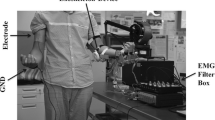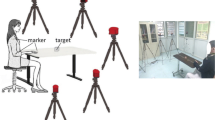Abstract
To explore the stroke- and aging-induced neurological changes in paretic muscles from an entropy point of view, fuzzy approximate entropy (fApEn) was utilized to represent the complexity of EMG signals in elbow-tracking tasks. In the experiment, 11 patients after stroke and 20 healthy control subjects (10 young and 10 age-matched adults) were recruited and asked to perform elbow sinusoidal trajectory tracking tasks. During the tests, the elbow angle and electromyographic (EMG) signals of the biceps brachii and triceps brachii were recorded simultaneously. The results showed significant differences in fApEn values of both biceps and triceps EMG among four groups at six velocities (p < 0.01), with fApEn values in the following order: affected sides of stroke patients < unaffected sides of stroke patients < age-matched controls < young controls. A possible mechanism underlying the smaller fApEn values in the affected sides in comparison with aged-matched controls and in the aged individuals in comparison with young controls might be the reduction in the number and firing rate of active motor units. This method and index provide evidence of neurological changes after stroke and aging by complexity analysis of the surface EMG signals. Further studies are needed to validate and facilitate the application in clinic.








Similar content being viewed by others
References
Akataki, K., K. Mita, M. Watakabe, and K. Itoh. Mechanomyogram and force relationship during voluntary isometric ramp contractions of the biceps brachii muscle. Eur. J. Appl. Physiol. 84:19–25, 2001.
Brown, W. F., and R. Snow. Denervation in hemiplegic muscles. Stroke 21:1700–1704, 1990.
Caldirola, D., L. Bellodi, A. Caumo, G. Migliarese, and G. Perna. Approximate entropy of respiratory patterns in panic disorder. Am. J. Psychiatry 161:79–87, 2004.
Canning, C. G., L. Ada, and N. J. O’Dwyer. Abnormal muscle activation characteristics associated with loss of dexterity after stroke. J. Neurol. Sci. 176:45–56, 2000.
Chen, W., Z. Wang, H. Xie, and W. Yu. Characterization of surface EMG signal based on fuzzy entropy. IEEE Trans. Neural Syst. Rehabil. Eng. 15:266–272, 2007.
Coderre, A. M., A. A. Zeid, S. P. Dukelow, M. J. Demmer, K. D. Moore, M. J. Demers, H. Bretzke, T. M. Herter, J. I. Glasgow, and K. E. Norman. Assessment of upper-limb sensorimotor function of subacute stroke patients using visually guided reaching. Neurorehabil. Neural Repair 24:528–541, 2010.
Costa, M., and J. Healey. Multiscale entropy analysis of complex heart rate dynamics: discrimination of age and heart failure effects. Comput. Cardiol. 30:705–708, 2003.
Cram, J. F., and G. S. Kasman. Introduction to Surface Electromyography. Gaithersburg: Aspen, pp. 316–321, 1998.
Desrosiers, J., D. Bourbonnais, G. Bravo, P.-M. Roy, and M. Guay. Performance of the ‘unaffected’upper extremity of elderly stroke patients. Stroke 27:1564–1570, 1996.
Duchene, J., and J. Y. Hogrel. A model of EMG generation. IEEE Trans. Biomed. Eng. 47:192–201, 2000.
Farina, D., L. Arendt-Nielsen, R. Merletti, and T. Graven-Nielsen. Effect of experimental muscle pain on motor unit firing rate and conduction velocity. J. Neurophysiol. 91:1250–1259, 2004.
Gabriel, D. A., and G. Kamen. Experimental and modeling investigation of spectral compression of biceps brachii SEMG activity with increasing force levels. J. Electromyogr. Kinesiol. 19:437–448, 2009.
Gemperline, J. J., S. Allen, D. Walk, and W. Z. Rymer. Characteristics of motor unit discharge in subjects with hemiparesis. Muscle Nerve 18:1101–1114, 1995.
Gitter, J. A., and M. J. Czerniecki. Fractal analysis of the electromyographic interference pattern. J. Neurosci. Methods 58:103–108, 1995.
Glendinning, D. S., and R. M. Enoka. Motor unit behavior in Parkinson’s disease. Phys. Ther. 74:61–70, 1994.
Hong, S. L., and K. M. Newell. Motor entropy in response to task demands and environmental information. Chaos 18:033131, 2008.
Hu, X., C. Miller, P. Vespa, and M. Bergsneider. Adaptive computation of approximate entropy and its application in integrative analysis of irregularity of heart rate variability and intracranial pressure signals. Med. Eng. Phys. 30:631–639, 2008.
Huo, Y. Current status and development of percutaneous coronary intervention in China. J. Zhejiang Univ. Sci. B 11:631–633, 2010.
Jennifer, M. Y., H. Nathaniel, K. S. Kendra, P. K. Jeffrey, M. Denise, and S. Nicholas. The appropriate use of approximate entropy and sample entropy with short data sets. Ann. Biomed. Eng. 41:349–365, 2013.
Kallenberg, L. A., and H. J. Hermens. Motor unit properties of biceps brachii in chronic stroke patients assessed with high-density surface EMG. Muscle Nerve 39:177–185, 2009.
Kojović, J., N. Miljković, M. M. Janković, and D. B. Popović. Recovery of motor function after stroke: a polymyography-based analysis. J. Neurosci. Methods 194:321–328, 2011.
Li, X., W. Z. Rymer, and P. Zhou. A simulation-based analysis of motor unit number index (MUNIX) technique using motoneuron pool and surface electromyogram models. IEEE Trans. Neural Syst. Rehabil. Eng. 20:297–304, 2012.
Li, X., Y. C. Wang, N. L. Suresh, W. Rymer, and P. Zhou. Motor unit number reductions in paretic muscles of stroke survivors. IEEE Trans. Inf. Technol. Biomed. 15:505–512, 2011.
Lodha, N., S. K. Naik, S. A. Coombes, and J. H. Cauraugh. Force control and degree of motor impairments in chronic stroke. Clin. Neurophysiol. 121:1952–1961, 2010.
Lukacs, M., L. Vecsei, and S. Beniczky. Large motor units are selectively affected following a stroke. Clin. Neurophysiol. 119:2555–2558, 2008.
Lum, P., D. Reinkensmeyer, R. Mahoney, W. Z. Rymer, and C. Burgar. Robotic devices for movement therapy after stroke: current status and challenges to clinical acceptance. Top. Stroke Rehabil. 8:40–53, 2002.
McNeil, C. J., T. J. Doherty, D. W. Stashuk, and C. L. Rice. Motor unit number estimates in the tibialis anterior muscle of young, old, and very old men. Muscle Nerve 31:461–467, 2005.
Mukul, M., K. Panagiotis, S. Ka-Chun, B. F. Pierre, and S. Nicholas. Stroke survivors control the temporal structure of variability during reaching in dynamic environments. Ann. Biomed. Eng. 41:366–376, 2013.
Padmanabhan P. and S. Puthusserypady. Nonlinear analysis of EMG signals—a chaotic approach. In: 26th Annual International Conference of the IEEE EMBS. 2004, p. 608–611.
Pincus, S. M. Approximate entropy as a measure of system complexity. Proc. Natl. Acad. Sci. 88:2297–2301, 1991.
Pincus, S. M., and A. L. Goldberger. Physiological time-series analysis: what does regularity quantify? Am. J. Physiol. Heart Circ. Physiol. 266:H1643–H1656, 1994.
Richman, J. S., and J. R. Moorman. Physiological time-series analysis using approximate entropy and sample entropy. Am. J. Physiol. Heart Circ. Physiol. 278:H2039–H2049, 2000.
Rohrer, B., S. Fasoli, H. I. Krebs, R. Hughes, B. Volpe, W. R. Frontera, J. Stein, and N. Hogan. Movement smoothness changes during stroke recovery. J. Neurosci. 22:8297–8304, 2002.
Roos, M. R., C. L. Rice, and A. A. Vandervoort. Age-related changes in motor unit function. Muscle Nerve 20:679–690, 1997.
Rosenfalck, A., and S. Andreassen. Impaired regulation of force and firing pattern of single motor units in patients with spasticity. J. Neurol. Neurosurg. Psychiatry 43:907–916, 1980.
Sethi, A., S. Davis, T. McGuirk, T. S. Patterson, and L. G. Richards. Effect of intense functional task training upon temporal structure of variability of upper extremity post stroke. J. Hand Ther. 26:132–138, 2013.
Song, R., K. Y. Tong, and X. L. Hu. Evaluation of velocity-dependent performance of the spastic elbow during voluntary movements. Arch. Phys. Med. Rehabil. 89:1140–1145, 2008.
Soylu, A. R., and P. Arpinar-Avsar. Detection of surface electromyography recording time interval without muscle fatigue effect for biceps brachii muscle during maximum voluntary contraction. J. Electromyogr. Kinesiol. 20:773–776, 2010.
Sun, R., R. Song, and K. Y. Tong. Complexity analysis of EMG signals for patients after stroke during robot-aided rehabilitation training using fuzzy approximate entropy. IEEE Trans. Neural Syst. Rehabil. Eng. 22:1013–1019, 2014.
Viitasalo, J. T., and P. V. Komi. Effects of fatigue on isometric force-and relaxation-time characteristics in human muscle. Acta Physiol. Scand. 111:87–95, 1981.
Wang, W., A. D. Stefano, and R. Allen. A simulation model of the surface EMG signal for analysis of muscle activity during the gait cycle. Comput. Biol. Med. 36:601–618, 2006.
Webber, C. L., M. A. Schmidt, and J. M. Walsh. Influence of isometric loading on biceps EMG dynamics as assessed by linear and nonlinear tools. J. Appl. Physiol. 78:814–822, 1995.
Xie, H. B., W. T. Chen, W. X. He, and H. Liu. Complexity analysis of the biomedical signal using fuzzy entropy measurement. Appl. Soft Comput. 11:2871–2879, 2011.
Xie, H. B., J. Y. Guo, and Y. P. Zheng. Fuzzy approximate entropy analysis of chaotic and natural complex systems: detecting muscle fatigue using electromyography signals. Ann. Biomed. Eng. 38:1483–1496, 2010.
Xie, J., E. Q. Wu, Z. J. Zheng, J. B. Croft, K. J. Greenlund, G. A. Mensah, and D. R. Labarthe. Impact of stroke on health-related quality of life in the noninstitutionalized population in the United States. Stroke 37:2567–2572, 2006.
Xiong, G., L. Zhang, H. Liu, H. Zou, and W. Guo. A comparative study on ApEn, SampEn and their fuzzy counterparts in a multiscale framework for feature extraction. J. Zhejiang Univ. Sci. A 11:270–279, 2010.
Zadeh, L. A. Fuzzy sets. Inf. Control 8:338–353, 1965.
Zhou, P., P. E. Barkhaus, X. Zhang, and W. Z. Rymer. Characterizing the complexity of spontaneous motor unit patterns of amyotrophic lateral sclerosis using approximate entropy. J. Neural Eng. 8:066010, 2011.
Zhou, P., N. L. Suresh, and W. Z. Rymer. Model based sensitivity analysis of EMG–force relation with respect to motor unit properties: applications to muscle paresis in stroke. Ann. Biomed. Eng. 35:1521–1531, 2007.
Acknowledgments
The project was supported by the National Natural Science Foundation of China (Grant No. 61273359) and the Guangdong Natural Science Foundation (Grant No. S2012010010350).
Author information
Authors and Affiliations
Corresponding author
Additional information
Associate Editor Xiaoxiang Zheng oversaw the review of this article.
Rights and permissions
About this article
Cite this article
Ao, D., Sun, R., Tong, Ky. et al. Characterization of Stroke- and Aging-Related Changes in the Complexity of EMG Signals During Tracking Tasks. Ann Biomed Eng 43, 990–1002 (2015). https://doi.org/10.1007/s10439-014-1150-1
Received:
Accepted:
Published:
Issue Date:
DOI: https://doi.org/10.1007/s10439-014-1150-1




